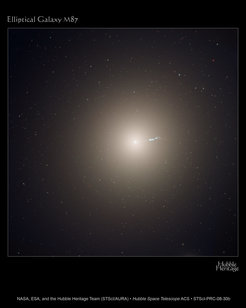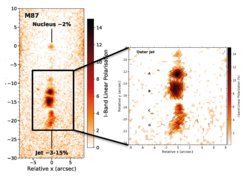The twisted jet and the weakly polarised nucleus in M87

Massive black holes are complex environments involving high-energy physics, where accelerated particles are collimated along the system axis. These processes lead to the formation of prominent jets that extend for several kiloparsecs beyond the boundaries of their host galaxies. The polarisation of the light encodes valuable information on the physical conditions and the magnetic field configuration in the vicinity of the black hole, where this radiation was emitted. When observed in polarised light, the nucleus of M87 looks much fainter and less polarised than the extended jet, which reaches a remarkable polarisation degree above 20%. This difference reflects the complexity of the nuclear region, where the jet structure shrinks down to the smallest physical scales.
"By mapping the orientation angle of the polarised light, we can trace the helical structure of the magnetic field distribution in the jet,” explains Alejandra Fresco, who is currently working on her PhD at Andrea Merloni (MPE) and Celine Peroux (ESO). “This structure is usually formed in jets due to the angular momentum carried by the ejected material, which twists the magnetic field lines along the jet direction." This is revealed by a characteristic pattern where neighbouring sections in the jet emit polarised light with perpendicular orientations.

Detailed observations of the core of M87 reveal that the nucleus looks much fainter and less polarised than the extended jet, which reaches a remarkable polarisation degree above 20%. The zoomed image shows the knots of the jet (A, B, C and G) with their correspondent linear polarisation in the I-band; the black lines on top are the polarisation angle for each knot respectively.
An additional result of the study is the low level of activity in the vicinity of the nucleus during the observations. HST-1, a famous recollimation region that became even brighter than the nucleus during a period of flaring activity during 2005-2007, is barely detected in the ALFOCS images from April 2017. X-ray observations with the Chandra Telescope during the same epoch confirm these observations.
This project was carried out in collaboration with the IAC researchers Juan Antonio Fernández Ontiveros, Almudena Prieto, and Jose Antonio Acosta Pulido, and was possible due to the unique polarimetric capabilities of the ALFOSC instrument mounted on the Nordic Optical Telescope (NOT), at the Roque de los Muchachos Observatory in La Palma.













